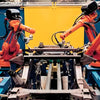How TOF Cameras Power 3D Sensing and Gesture Control in Smartphones

How Do TOF Cameras in Smartphones Enable 3D Sensing and Contactless Control?
With the rapid evolution of smartphones, users increasingly expect devices that not only capture stunning images but also understand spatial depth and motion. TOF (Time-of-Flight) cameras, a new generation of 3D sensing sensors, are redefining how smartphones perceive the world. From accurate facial recognition to immersive AR/VR experiences, TOF technology is quietly becoming the core of intelligent, contactless interaction. This article explores the principles, accuracy and precision, practical applications, and future trends of TOF technology in smartphones.
What Is the Difference Between Accuracy and Precision in TOF Cameras?
In TOF-based measurement systems, accuracy and precision determine how reliable the depth data is.
-
Accuracy reflects how close a measured value is to the actual distance. For example, if a TOF sensor measures a wall 200 cm away and the true distance is 200 cm, the measurement is highly accurate.
-
Precision, however, describes how consistent multiple measurements are under the same condition. If a sensor repeatedly measures 198 cm, 199 cm, and 198 cm, its results are very precise—even if slightly less accurate.
Examples in smartphone TOF applications:
-
High Accuracy + High Precision: AR objects appear stable and perfectly aligned with the real world.
-
High Accuracy + Low Precision: The object’s average position is correct, but it may flicker or drift.
-
Low Accuracy + High Precision: The object remains stable but slightly misplaced.
-
Low Accuracy + Low Precision: The AR display becomes unstable and unreliable.
For smartphone TOF cameras, achieving both high accuracy and high precision is crucial for AR alignment, face recognition reliability, and depth perception. Understanding “accuracy vs precision” is therefore essential for evaluating sensor quality and overall 3D performance.
1. The Evolution and Current State of TOF Technology in Smartphones
Originally designed for industrial and automotive applications such as 3D scanning and robotic distance measurement, TOF sensors have now entered the consumer electronics market thanks to miniaturization and lower production costs. Smartphones became a natural platform for this transition due to their increasing computational power and need for advanced imaging.
The introduction of TOF cameras in flagship phones around 2017 marked a key turning point. For instance, Huawei pioneered early consumer TOF depth cameras to enhance 3D portrait photography and facial recognition. Apple soon integrated LiDAR-based TOF systems for Face ID and AR applications, setting a new industry benchmark.
Today, almost every major smartphone brand explores TOF for depth photography, AR navigation, and secure identity verification—making it a key differentiator in the competitive mobile market.
2. TOF and 3D Face Recognition: Security Meets Speed
Traditional 2D face recognition relies on flat RGB imagery, which can be fooled by photos or masks and is sensitive to lighting variations. TOF cameras, however, use infrared (IR) light pulses to measure how long it takes for the light to reflect back. This enables real-time 3D facial mapping and contour reconstruction, making recognition systems both faster and more secure.
By analyzing 3D data, TOF cameras distinguish between a real human face and a static photo, preventing spoofing attempts. When combined with AI-driven liveness detection, they can detect micro-expressions, subtle movements, and even blood flow under the skin to confirm a living user. This dual-layer verification system dramatically improves payment security and privacy protection.
Additionally, TOF systems maintain performance in low-light environments, since infrared light is independent of ambient illumination. Users can unlock their devices or authorize transactions at night without compromising accuracy.
With the help of machine learning, future TOF cameras will be able to analyze facial emotions, recognize partial faces (with masks or glasses), and combine multiple biometric factors for multi-modal authentication—paving the way for smarter and more adaptive smartphone security.
3. AR/VR, Gesture Control, and Spatial Awareness Powered by TOF
Beyond face recognition, TOF sensors open new possibilities for AR (Augmented Reality) and VR (Virtual Reality) by enabling real-time 3D environmental perception. Unlike traditional RGB cameras, TOF depth sensors calculate the flight time of light to generate precise depth maps, allowing the phone to reconstruct its surroundings in millimeter detail.
Key smartphone applications include:
-
AR Interior Design and Virtual Try-On: TOF cameras allow users to visualize how furniture fits in a room or try on clothes virtually. The accurate depth data ensures virtual objects maintain correct scale and position, enhancing realism and user confidence.
-
Gesture Recognition: With TOF, smartphones can interpret hand motions such as swipes, pinches, and rotations in 3D space, enabling touchless control for gaming, UI navigation, and accessibility functions.
-
3D Scanning and Content Creation: Creators can scan physical objects with a smartphone to instantly generate 3D models complete with depth and texture—useful for digital art, game design, and AR social media effects.
Moreover, TOF continuously updates depth information in dynamic scenes. In multi-user AR meetings or collaborative design tools, this ensures accurate object alignment and interaction between virtual and real environments. The result is smoother, more natural spatial engagement for both entertainment and professional use.
4. How Major Brands Implement TOF Cameras: Apple, Huawei, and Xiaomi
Different smartphone manufacturers have tailored TOF technology to their ecosystems:
-
Apple: Integrates TOF with LiDAR for precision face recognition, AR home layout visualization, and ARKit-based game development.
-
Huawei: Focuses on 3D imaging, portrait enhancement, and AR measurement utilities.
-
Xiaomi: Implements TOF modules for AR games, 3D scanning, and gesture-based app control.
While Apple emphasizes security and ecosystem synergy, Huawei leans toward photography and multi-scenario depth features, and Xiaomi highlights immersive entertainment. Each approach underscores the flexibility of TOF sensors across different smartphone experiences.
5. Future Outlook: The Integration of TOF and AI for Intelligent Interaction
The next phase of smartphone innovation will see TOF technology merging with AI to create smarter, context-aware devices.
This combination will transform smartphones from passive tools into intelligent companions capable of understanding environments, recognizing users, and predicting actions.
Smart Home Integration:
With TOF + AI, phones can become gesture-based controllers for home appliances. A hand wave could dim lights, adjust temperature, or control a smart TV. The system learns behavioral patterns to automate settings for comfort and energy efficiency.
AR Enhancement and Spatial Intelligence:
AI-driven interpretation of TOF depth data enables devices to recognize furniture, walls, and movement paths. This leads to more realistic AR object placement, improved navigation guidance, and immersive gaming experiences.
Health and Fitness Tracking:
TOF sensors can capture full-body 3D motion for fitness apps, analyzing posture, gait, and exercise form in real time. Combined with AI, they can monitor breathing or movement habits, providing personalized health recommendations and ergonomics feedback.
As sensor resolution increases and AI algorithms evolve, smartphones will evolve into 3D perception hubs—central to smart living, spatial computing, and human-centric interaction.
Conclusion
TOF cameras are revolutionizing how smartphones perceive and interact with the world. By providing accurate, precise, and real-time 3D sensing, they empower new applications from secure facial recognition to immersive AR/VR and gesture-based control.
As TOF technology integrates deeper with AI and spatial computing, smartphones will move beyond communication to become intelligent, perceptive companions that seamlessly blend the digital and physical worlds.
AllSENSOR 20M Outdoor Fully Solid-State LiDAR S150
After-sales Service: Our professional technical support team specializes in TOF camera technology and is always ready to assist you. If you encounter any issues during the usage of your product after purchase or have any questions about TOF technology, feel free to contact us at any time. We are committed to providing high-quality after-sales service to ensure a smooth and worry-free user experience, allowing you to feel confident and satisfied both with your purchase and during product use.








